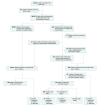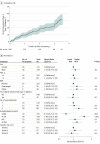Yield of a Public Health Screening of Children for Islet Autoantibodies in Bavaria, Germany
- PMID: 31990315
- PMCID: PMC6990943
- DOI: 10.1001/jama.2019.21565
Yield of a Public Health Screening of Children for Islet Autoantibodies in Bavaria, Germany
Abstract
Importance: Public health screening for type 1 diabetes in its presymptomatic stages may reduce disease severity and burden on a population level.
Objective: To determine the prevalence of presymptomatic type 1 diabetes in children participating in a public health screening program for islet autoantibodies and the risk for progression to clinical diabetes.
Design, setting, and participants: Screening for islet autoantibodies was offered to children aged 1.75 to 5.99 years in Bavaria, Germany, between 2015 and 2019 by primary care pediatricians during well-baby visits. Families of children with multiple islet autoantibodies (presymptomatic type 1 diabetes) were invited to participate in a program of diabetes education, metabolic staging, assessment of psychological stress associated with diagnosis, and prospective follow-up for progression to clinical diabetes until July 31, 2019.
Exposures: Measurement of islet autoantibodies.
Main outcomes and measures: The primary outcome was presymptomatic type 1 diabetes, defined by 2 or more islet autoantibodies, with categorization into stages 1 (normoglycemia), 2 (dysglycemia), or 3 (clinical) type 1 diabetes. Secondary outcomes were the frequency of diabetic ketoacidosis and parental psychological stress, assessed by the Patient Health Questionnaire-9 (range, 0-27; higher scores indicate worse depression; ≤4 indicates no to minimal depression; >20 indicates severe depression).
Results: Of 90 632 children screened (median [interquartile range {IQR}] age, 3.1 [2.1-4.2] years; 48.5% girls), 280 (0.31%; 95% CI, 0.27-0.35) had presymptomatic type 1 diabetes, including 196 (0.22%) with stage 1, 17 (0.02%) with stage 2, 26 (0.03%) with stage 3, and 41 who were not staged. After a median (IQR) follow-up of 2.4 (1.0-3.2) years, another 36 children developed stage 3 type 1 diabetes. The 3-year cumulative risk for stage 3 type 1 diabetes in the 280 children with presymptomatic type 1 diabetes was 24.9% ([95% CI, 18.5%-30.7%]; 54 cases; annualized rate, 9.0%). Two children had diabetic ketoacidosis. Median (IQR) psychological stress scores were significantly increased at the time of metabolic staging in mothers of children with presymptomatic type 1 diabetes (3 [1-7]) compared with mothers of children without islet autoantibodies (2 [1-4]) (P = .002), but declined after 12 months of follow-up (2 [0-4]) (P < .001).
Conclusions and relevance: Among children aged 2 to 5 years in Bavaria, Germany, a program of primary care-based screening showed an islet autoantibody prevalence of 0.31%. These findings may inform considerations of population-based screening of children for islet autoantibodies.
Conflict of interest statement
Figures




References
-
- Große J, Hornstein H, Manuwald U, Kugler J, Glauche I, Rothe U. Incidence of diabetic ketoacidosis of new-onset type 1 diabetes in children and adolescents in different countries correlates with human development index (HDI): an updated systematic review, meta-analysis, and meta-regression. Horm Metab Res. 2018;50(3):209-222. doi:10.1055/s-0044-102090 - DOI - PubMed
-
- Wolfsdorf JI, Allgrove J, Craig ME, et al. ; International Society for Pediatric and Adolescent Diabetes . ISPAD Clinical Practice Consensus Guidelines 2014: diabetic ketoacidosis and hyperglycemic hyperosmolar state. Pediatr Diabetes. 2014;15(suppl 20):154-179. doi:10.1111/pedi.12165 - DOI - PubMed
-
- Elding Larsson H, Vehik K, Bell R, et al. ; TEDDY Study Group; SEARCH Study Group; Swediabkids Study Group; DPV Study Group; Finnish Diabetes Registry Study Group . Reduced prevalence of diabetic ketoacidosis at diagnosis of type 1 diabetes in young children participating in longitudinal follow-up. Diabetes Care. 2011;34(11):2347-2352. doi:10.2337/dc11-1026 - DOI - PMC - PubMed
MeSH terms
Substances
LinkOut - more resources
Full Text Sources
Other Literature Sources
Medical

